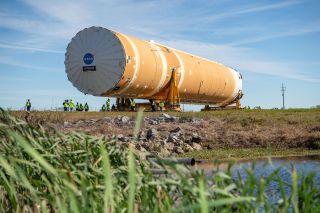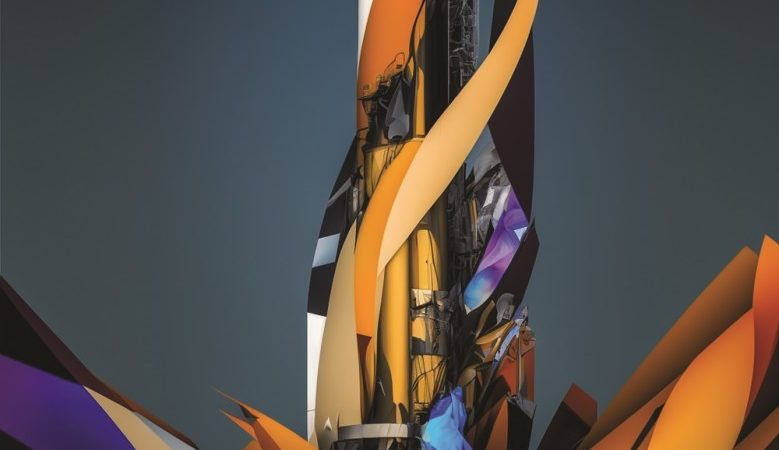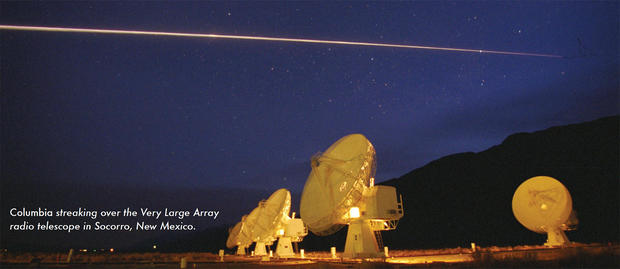NASA’s 1st SLS Megarocket Core Loaded Onto Barge Ahead of Key Engine Test – Space.com
The heart of NASA’s first Space Launch System (SLS) megarocket is on the move.
The 212-foot-long (65 meters) SLS core stage rolled out of NASA’s Michoud Assembly Facility in New Orleans Wednesday (Jan. 8) and was loaded onto a barge, agency officials announced.
That barge will soon depart for NASA’s Stennis Space Center in Mississippi, where the booster will endure a crucial, months-long “green run” test designed to demonstrate its fitness to send astronauts to the moon, Mars and other deep-space destinations.
Related: Watch NASA’s SLS Megarocket Get Ready for US Moon Missions (Video)
A jazz band from a local high school escorted the booster out to the road Wednesday, said John Shannon, SLS vice president and program manager at Boeing, the prime contractor for the rocket’s core stage.
“It was just a fantastic way to celebrate this historic milestone — sending the most complicated vehicle that’s ever been built at Michoud, by far, out on its way to the test facility,” Shannon said during a call with reporters on Wednesday afternoon.
The journey to Stennis will take about 9 hours, he added. The voyage is not yet underway, however; the travel date depends on the weather.
The SLS is key to NASA’s human spaceflight plans. The rocket’s first iteration, known as the Block 1, will stand 322 feet (98 m) tall and generate 8.8 million lbs. of maximum thrust at liftoff — 15% more than the agency’s iconic Saturn V rocket, which launched the Apollo missions to the surface of the moon. The SLS core stage’s four RS-25 engines will provide about 2 million lbs. of that thrust; the rest will come from two strap-on solid rocket boosters.
The future Block 2 SLS will be even brawnier, producing nearly 12 million lbs. of maximum thrust at liftoff.

The core that just left Michoud will fly in the Block 1 configuration, on the very first flight of the SLS. That mission, known as Artemis 1, will launch NASA’s Orion capsule on an uncrewed journey around the moon. Artemis 1 is currently scheduled to launch no earlier than November of this year.
But the SLS core has to pass the green run before Artemis 1 can get off the ground. That test series will put the core stage through its paces, checking out its many complicated and interconnected subsystems and ultimately lighting up the four RS-25 engines for a full 8 minutes — the amount of time they’ll fire on an actual mission to the moon. (The “green” in “green run,” by the way, refers to the previously untested nature of the hardware on the stand.)
If everything goes well with the green run and Mother Nature cooperates, the test campaign could wrap up by July or August, Shannon said. But weather issues, and the need to refurbish the core after various subtests, may well push completion into October, he added.
After the green run is done, the core stage will take another, much longer barge trip — an eight- to 12-day trek around Florida’s west coast and back up the state’s east side to NASA’s Kennedy Space Center, the Artemis 1 launch site.
Related: Photos: NASA’s Space Launch System for Deep-Space Flights
Artemis 1, in turn, is just the first of many planned missions in NASA’s Artemis program, which seeks to land two astronauts near the lunar south pole by 2024 and establish a long-term, sustainable human presence on and around the moon by 2028.
Artemis 2, another lunar flyby, will be the first crewed flight of SLS and Orion. That mission is currently targeted for late 2022.
The SLS program has endured a series of cost overruns and delays. Indeed, a 2015 assessment estimated that the first core stage would be done by the end of 2017, Shannon said.
“So, we’re about two years late,” he said. “Boeing completely owns that.”
Shannon cited two main issues that led to this latest delay. The first involved the new tooling used to weld the core stage together, as well as problems with the welding process itself.
“The other issue, I think, that caused us some difficulty was, we really underestimated the complexity of building the engine section, which is the very bottom of the rocket that holds all of the propulsion elements and all of the TVC [thrust vector control] and hydraulic elements,” Shannon said.
But Boeing learned a great deal from this first build and is already applying the lessons, he added, stressing that the second SLS core is coming together at Michoud 40% faster than the first one did.
NASA Deputy Administrator Jim Morhard — who also participated in today’s call, along with NASA SLS Program Manager John Honeycutt — said that delays are to be expected when building something as big and complex as an SLS core stage for the first time. And Morhard stressed that the future is bright for SLS and the Artemis program.
“There’s a lot more to come,” Morhard said.
Mike Wall’s book about the search for alien life, “Out There” (Grand Central Publishing, 2018; illustrated by Karl Tate), is out now. Follow him on Twitter @michaeldwall. Follow us on Twitter @Spacedotcom or Facebook.







